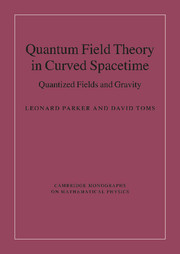Book contents
- Frontmatter
- Contents
- Preface
- Acknowledgments
- Conventions and notation
- 1 Quantum fields in Minkowski spacetime
- 2 Basics of quantum fields in curved spacetimes
- 3 Expectation values quadratic in fields
- 4 Particle creation by black holes
- 5 The one-loop effective action
- 6 The effective action: Non-gauge theories
- 7 The effective action: Gauge theories
- Appendix: Quantized Inflaton Perturbations
- References
- Index
4 - Particle creation by black holes
Published online by Cambridge University Press: 25 January 2011
- Frontmatter
- Contents
- Preface
- Acknowledgments
- Conventions and notation
- 1 Quantum fields in Minkowski spacetime
- 2 Basics of quantum fields in curved spacetimes
- 3 Expectation values quadratic in fields
- 4 Particle creation by black holes
- 5 The one-loop effective action
- 6 The effective action: Non-gauge theories
- 7 The effective action: Gauge theories
- Appendix: Quantized Inflaton Perturbations
- References
- Index
Summary
Introduction
We have already seen how time-dependent gravitational fields, such as occur in cosmology, can give rise to the creation of elementary particles. The time development of a quantum field induces a redefinition of creation and annihilation operators that correspond to physical particles. For example, the annihilation operators of particles at late times can be expressed as superpositions of annihilation and creation operators of particles at early times. This superposition is known as a Bogolubov transformation. The coefficients in the superposition determine the probability of creation of pairs of elementary particles by the gravitational field.
This method of using Bogolubov transformations to analyze particle creation by gravitational fields was first introduced by Parker (1965, 1968, 1969, 1971) in the cosmological context. Fulling (1972, 1973) found that the creation and annihilation operators defined in an accelerated coordinate system (known as Rindler coordinates (Rindler 1966)) in Minkowski spacetime were related to the usual Minkowski creation and annihilation operators through a Bogolubov transformation. This was shown by Unruh (1976) to imply that an accelerated particle detector in empty Minkowski spacetime would respond as if it were observing a flux of particles. The particle spectrum corresponding to the Bogolubov transformation of Fulling was a thermal spectrum with a temperature determined by the acceleration (Davies 1975).
Several investigations of particle creation by black holes were also in progress at this time.
- Type
- Chapter
- Information
- Quantum Field Theory in Curved SpacetimeQuantized Fields and Gravity, pp. 152 - 183Publisher: Cambridge University PressPrint publication year: 2009



